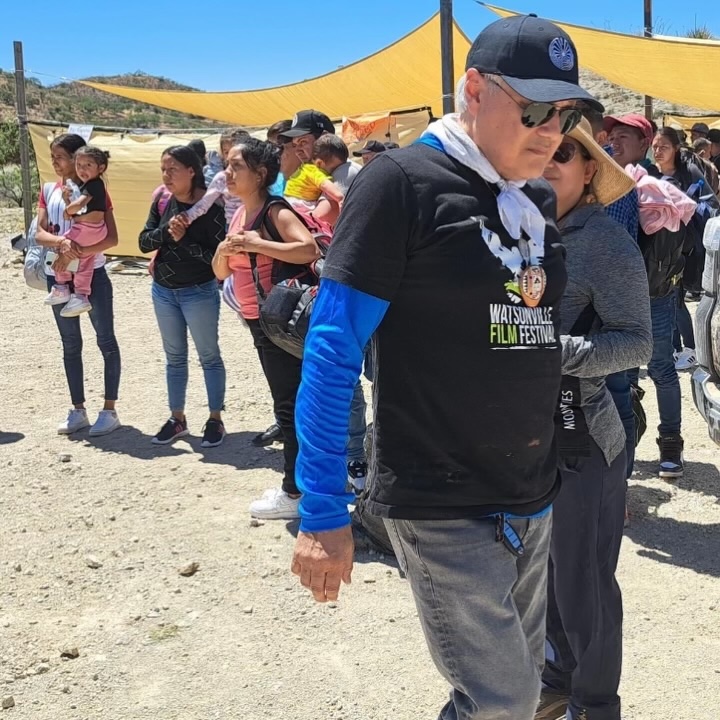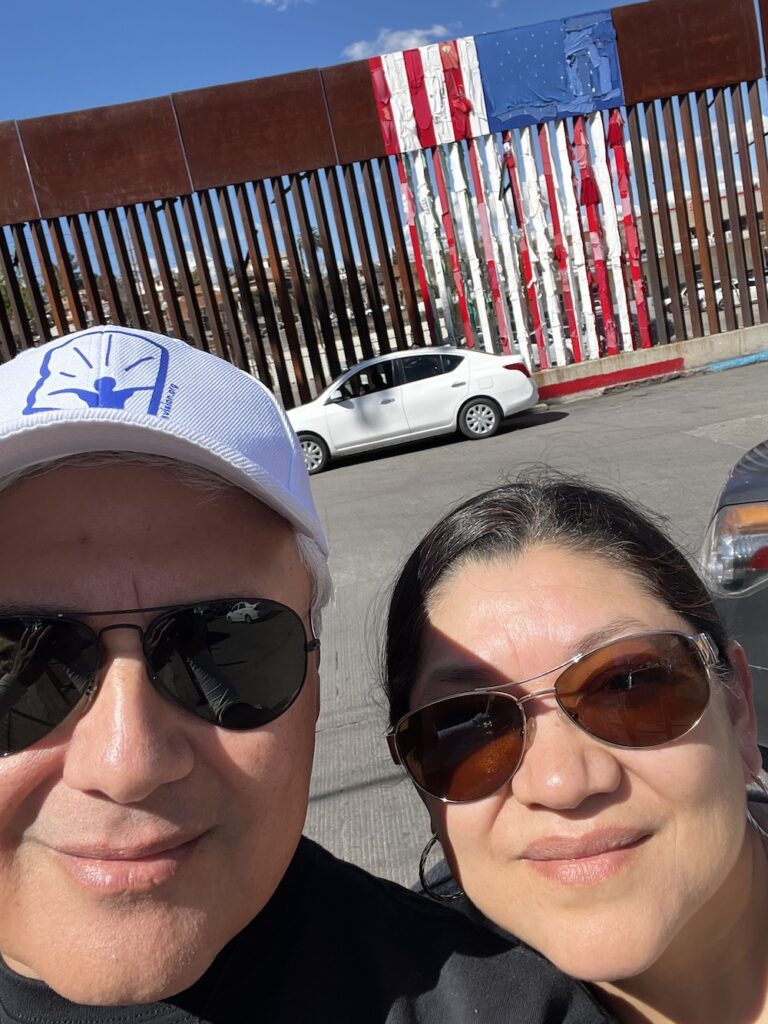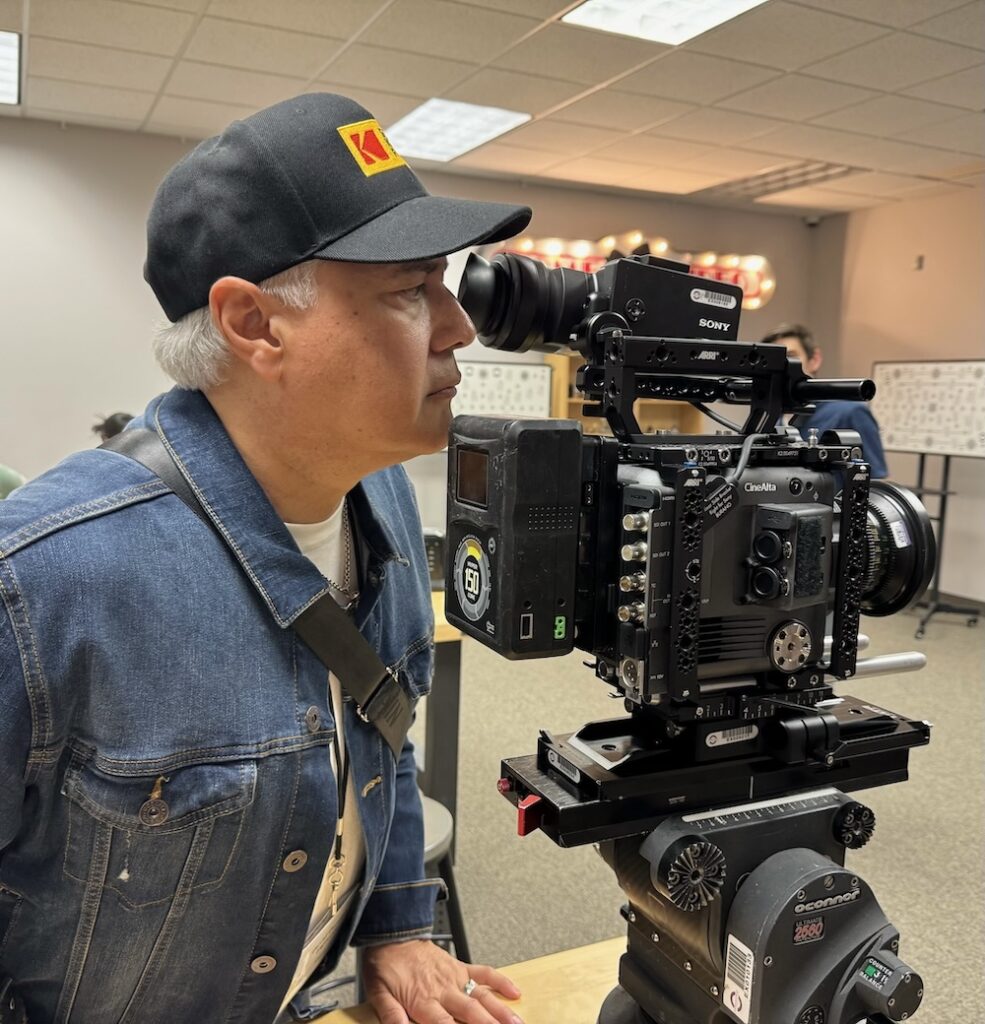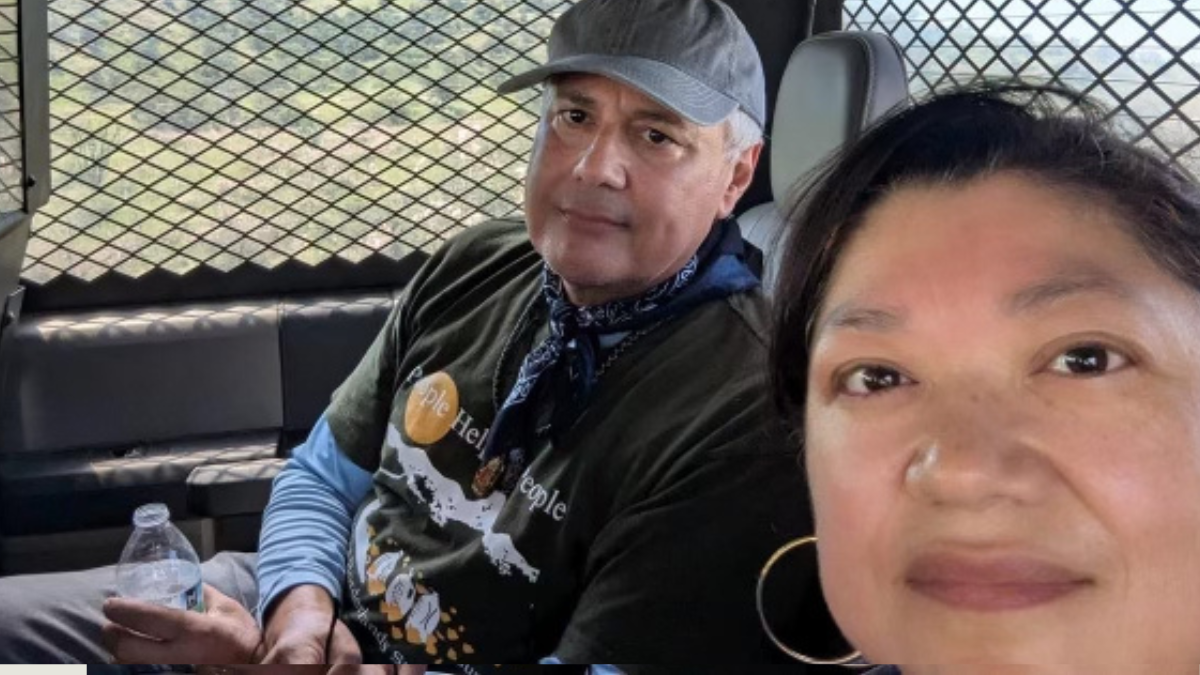By David Damian Figueroa, Writer/Producer/Director
A first hand account of racial profiling at the Arizona border written by filmmaker David Damian Figueroa, brings to light the danger people of color put themselves in, whether U.S. citizens or not– in this case a crew of American documentarians.
The Border Patrol truck snuck up behind us, flashing its red lights. We stopped on the dirt road, wondering why we were being pulled over.
It was around 10 a.m. on August 14, 2024, and we were a few miles from the border wall. Our documentary film crew woke early to capture the sunrise at the border wall and spent the morning filming. For the past year, we have been taking trips to document the humanitarian work of Green Valley-Sahuarita and Tucson Samaritans on the Arizona border.
Our SUV belonged to the Green Valley-Sahuarita Samaritans and was marked with the organization’s logo—a white cross on a red background. Pastor Randy Mayer, co-founder of the Green Valley-Sahuarita Samaritans—had been driving and escorting our three-person film crew, which consisted of myself–one of the film directors—bestselling author Reyna Grande, who is one of our executive producers, and another crew member, who wishes to remain unnamed.
On our way back from the border wall, we passed a Border Patrol (BP) truck along Tres Bellotas Ranch Road. We waved to the officer from our easily identifiable SUV. He did not wave back. A customary, cordial, and unspoken practice between the humanitarian aid volunteers and the BP is to wave, stop, and report any sightings of stranded migrants at the end of the wall, then continue. Volunteers’ mission is to save lives, and the BP is there to apprehend migrants, although they save lives, too.
Soon after the BP officer stopped us, a loud helicopter circled above us. The officer approached our SUV. “Are you all United States citizens?” he asked.
We all answered affirmatively. The officer asked Pastor Randy to exit the car and grab the keys. The pastor immediately told him that his passengers were documentarians.
“Why are you stopping us?” I demanded.
“Vehicle inspection,” he said.
The officer ordered Pastor Randy, a white man, to open the back hatch of the SUV, and once he inspected our belongings, he slammed it shut. We could no longer hear them, and my apprehension grew.
After more than a year of filming in the Sonoran Desert, our documentary was nearing the end of production.

This past year has been one of the most historic times at the southern border. Thousands of migrants from all over the world were seeking asylum in the U.S. Our cameras captured the mass migration and interviewed asylum seekers from Sudan, Guinea, Morocco, India, Turkey, Russia, China, Mexico, Venezuela, and other countries throughout Central and South America. We filmed mainly on the Arizona side of the U.S.-Mexico border.
The overwhelming majority of the volunteers at this stretch of the border, the Tucson sector, which is considered the deadliest land crossing in the world, are older White Americans. The Samaritans range in age between 60 and 85 years old. Working in crews, these “badass” older White volunteers, both men and women, pack up their four-wheel-drive SUVs with food, water, and supplies and make the one-and-a-half-hour drive through the middle of the Sonoran Desert. No heat, rain, hail, or snow keeps them from showing up and helping migrants in need.
At the end of the long day, each volunteer is responsible for restocking and refilling the gas tank, powering portable chargers to hand out to migrants with dead cell phones, and washing the dusty vehicles. Once home, they must write a report of the day’s life-saving efforts so that, by Monday, they can present their findings, challenges, and encounters with the BP to the volunteer corps during the in-person meeting.
When the BP agent finished interrogating Pastor Randy, he came for me. He ordered me to get out of the car. “Do you have an ID with you? I have to establish citizenship on everyone here, okay?” he said.
He then took me behind our vehicle, where Pastor Randy sat under the hot sun on the car’s bumper. The officer asked me if we had crossed the border illegally. He mentioned that surveillance cameras were everywhere, and they saw two migrants with two white bags cross the border and get into our vehicle.
I explained that we had crossed the vehicle barriers at the end of the wall that morning–Reyna wanted to pick up trash litter in the area, and I wanted to film the sunrise from the other side of the wall–but we were still in the United States. In 1855, the U.S. government installed 276 obelisks to mark the U.S. boundary. The current border wall stands about twenty to thirty feet beyond the boundary on US soil. So, technically, we never left the United States.
A situation like ours would usually only take a few minutes to resolve by showing our US passport, but this BP officer had something else on his mind. He escorted me to the BP truck and ordered me to spread my legs and place my hands against the vehicle. He patted me down and touched my groin. Opening the door, he informed me that I was not under arrest, but he needed to call in a background check. He ordered me to enter the truck, which was caged and not ventilated, and then he shut the door, which automatically locked.

In 2014, I served as executive producer of the documentary Food Chains. The Samaritans invited me to screen the feature film at their annual conference called “Common Ground on the Border,” where I first heard of The Samaritans. I was intrigued. The unspoken truth is that this volunteer work has an element of danger. At the border wall, the vigilantes, militia, BP, the security for the wall construction crews, and the cartel carry pistols and machine guns. The volunteers are always unarmed, preferring to use their hands to carry gallons of water and food. These elders could be doing less dangerous volunteer assignments-like being a docent at the museum, reading to children at the local library, or helping give directions at an information booth at the local hospital or the airport. Why would these older White Americans, instead of enjoying their retirement doing leisurely–and safe–activities, be willing to devote their time, money, and energy to helping migrants at the wall and putting themselves in harm’s way?
I was determined to make a film about these courageous and compassionate people. The Samaritans inspired our entire production team and were up for the challenge of telling an alternative story of the border.
However, as a Latino filmmaker, I quickly noticed Latino volunteers’ absence among The Samaritans. “Where are the Latinos?” I would ask. I got a range of responses from the Latinos I asked–They were too busy working and raising families, or that the work was too dangerous, and they were afraid of getting hurt. When I pointed out that the Samaritan volunteers were facing those dangers, the pushback I would get is that because they were white, they had nothing to worry about. “They are privileged. Nobody is going to do anything to them,” was the response from one of the Latinos I interviewed.
I admit I was perplexed. Don’t we, as Latinos, have a responsibility to offer aid to our stranded Latino brothers and sisters in the desert?
Though I knew I would get some criticism for making a film about White people, not recognizing the work white humanitarians do at the border wall would be a disservice to our allies. I thought they would serve as role models for other white Americans, and hopefully, this film might encourage them to get more involved in helping migrants in need and shift their fear or bias. The volunteer work is not motivated by a White savior mentality, as some may think. Though our film might be centering on their perspective, we hope to capture and convey that the work these white volunteers do is nothing less than an act of radical love for humanity.

Equally important is for Latinos to witness this as well. If we executed our film correctly, we could send a powerful message to Latinos about working side by side in offering life-saving aid with our allies to stand up to injustice and do something about the human rights violations happening at the border. I thought it could encourage them to overcome their fears and reservations about volunteering.
The inside of the caged area of the Border Patrol truck was suffocatingly hot. To put our situation in perspective, leaving a child alone in a locked hot car for just fifteen minutes can be deadly. It is incomprehensible that any person with half a brain would think it was okay to force a person or persons into a hot vehicle and lock the windows and doors in the dead of summer. It made me think of all the migrants, alone and afraid and not speaking English, who have gone through this situation.
Through the grates on the window, I watched the BP officer return to The Samaritans’ SUV and order our film’s executive producer, Reyna Grande, out of the vehicle. After asking her repeatedly if she was in the country legally–all while holding her US passport in his hands–the officer escorted her to the vehicle and put her in the back with me. Oddly, once in the truck, the officer ordered her to frisk herself while he watched.
The migrants call the caged part of a BP vehicle “La Perrera” (The Kennel). Once both Reyna and I were in the kennel, under suspicion of crossing the border illegally or transporting migrants, it became apparent that in the eyes of the BP agent, the only crime Reyna and I had committed was being of Mexican descent.
The U.S. Customs and Border Protection, under which the BP operates, has a troubling history of racial profiling. Despite laws against it, a 2014 exception from the Obama Administration allows the BP to continue this practice within 100 miles of the border. This egregious practice has created a climate of fear and mistrust among Latino communities, with a Pew Research Center study finding that U.S. born Latinos are significantly more likely than other groups to fear deportation. According to the ACLU, “CBP’s militarization of the border region has produced rampant abuses ranging from racial profiling to excessive force,” with Latinos more likely to be stopped and searched at the border.
It brings to mind the rarely told stories of the nearly two million deportations, inspired by the anti-immigrant rhetoric and a shaky economy, of our American ancestors of Mexican descent from the 1930s and 1940s. This historical trauma continues to haunt Latino communities today.

The BP’s actions towards us were a stark reminder of this systemic bias. The officer’s insistence on repeatedly questioning our citizenship, being suspicious of us, and detaining us while he verified that we hadn’t crossed the border illegally or were transporting migrants, even while holding our U.S. passports in his hands, was a clear violation of our rights.
Now I understand why Latinos do not sign up as humanitarian volunteers in this section of the border wall. Latinos’ fear of being harassed or deported by the BP is a real fear.
“Okay, you can go now,” the officer said, opening the door to the vehicle and letting Reyna and me out of the hot truck. He returned our passports and escorted us to the Samaritan’s SUV.
As the helicopter stopped circling and flew away, I wondered what would have happened if we had not agreed to a vehicle inspection, even under probable cause, even though we had the right to remain silent and not answer questions without a lawyer. In that case, the consequences might not have ended well for us people of color.
As our production team continues to document the humanitarian work of The Samaritans, we are more determined than ever to shed light on the human rights violations happening at the border and the toll of unjust policies.

January 3, 2025, is the next session of the new Congress before the newly-elected President takes office on January 21st. No doubt, there will be rumblings of what to do about the border. Latino leaders and members of the Congressional Hispanic Congress must demand humane practices within the CBP and include them in a new immigration reform bill. We must also require that our newly-elected President undo the exemption that exists today that allows racial profiling by the BP and the U.S. Customs and Border Protection (CBP). It’s time to deal with the border like mature adults and make the necessary changes to an antiquated immigration system that refuses to acknowledge the contributions that Latinos have made and continue to make to the United States.
Our stories and history are valuable; we must continue advocating and fighting to tell them.



